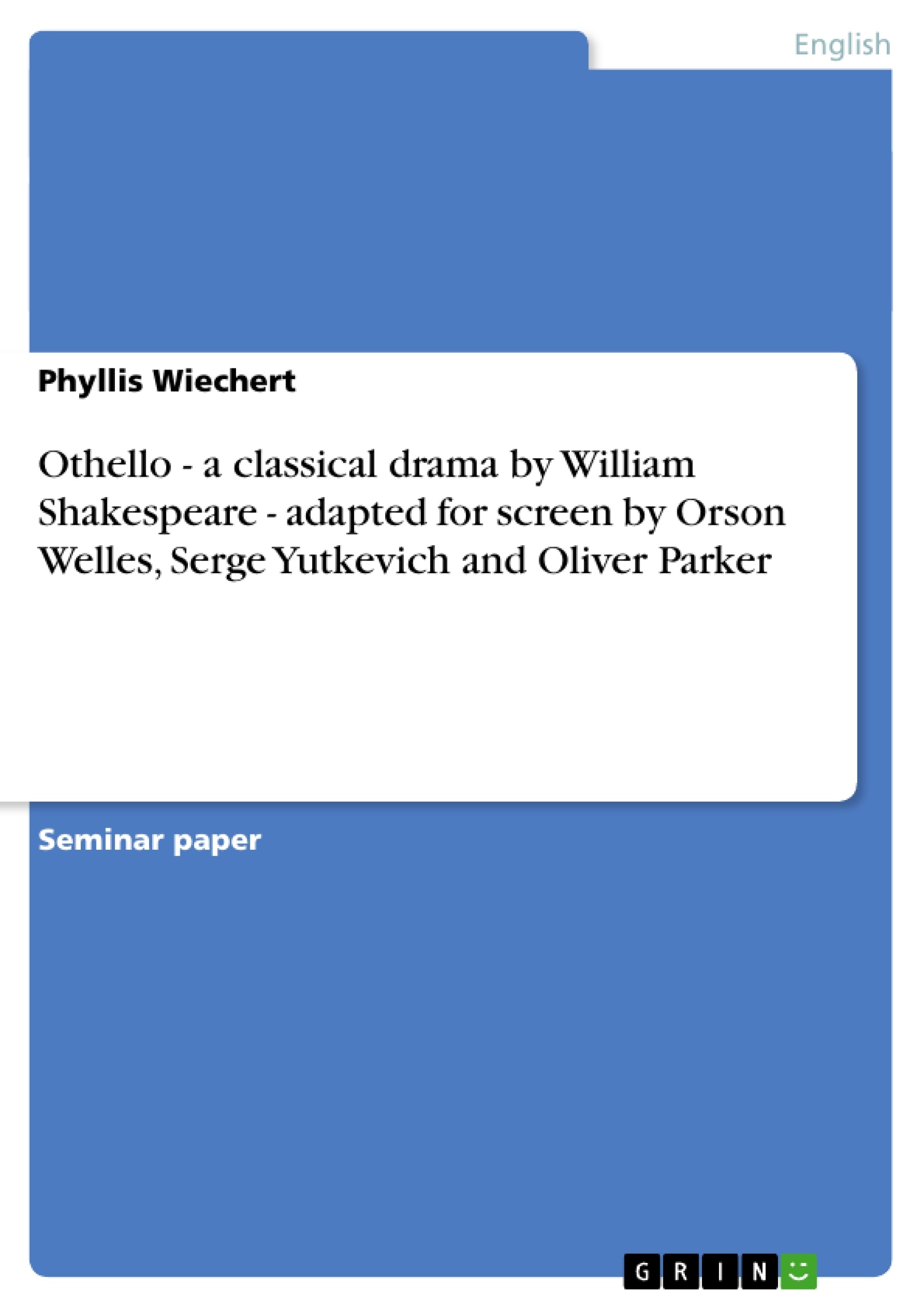There can hardly be two more different genres than a classical 16th century Shakespearian drama and a 20th century motion picture. But despite the enormous differences, many screen adaptations of Shakespeare’s plays have been produced. The purpose of this paper is to show how a classical Shakespearian tragedy such as Othello can be used as a basis for a 20th century motion picture and what changes the directors made in order to attract a modern audience with a Shakespearian play.
There are many adaptations of Othello, which are quite different. They range from word for word almost theatrical realisations of the play as for example the BBC version with Anthony Hopkins to modern adaptations such as the teenager movie “O” where only the main theme of Shakespeare’s Othello is kept and which is probably not recognised as a Shakespearian adaptation. In order to be able to compare the adaptations, this paper focuses on the adaptations of Othello by the directors Orson Welles, Serge Yutkevich and Oliver Parker. They are all fairly close to Shakespeare’s original but at the same time have some individual traits, which can only be found in these special versions of Othello. It should also be interesting to see how they can be distinguished according to the time when they were made, since the view and interpretation of Shakespeare’s play will differ depending on the time when the movie was directed.
According to the topic of this paper, a summary of Shakespeare’s Othello is not necessary since the general plot and a detailed knowledge of Shakespeare’s play is not crucial for the analysis of the motion pictures. The first main part of this paper gives descriptions of each adaptation. Selected key scenes will be illustrated in order to show the most distinctive features the adaptation has compared to the other adaptations. Then in the second main part the gathered information will be used in order to compare and contrast the different adaptations. A final conclusion restates and combines the facts in order to show how a classical drama can be used as a basis for a motion picture and in which way the directors made changes in order to create an interesting movie for the modern viewers.
Inhaltsverzeichnis (Table of Contents)
- Introduction
- Orson Welles' adaptation of Othello
- Special feature: camera work
- Special feature: bars and imprisonment
- Special feature: colour
- Special scenes
- Serge Yutkevich's adaptation of Othello
- Special feature: nature
- Special feature: camera work
- Special scenes
- Oliver Parker's adaptation of Othello
- Special feature: main characters
- Special feature: erotic and sexual images
- Special feature: lago's motive
- Special scenes
- Comparison of the adaptations
- Conclusion
Zielsetzung und Themenschwerpunkte (Objectives and Key Themes)
This paper explores the adaptation of Shakespeare's Othello for the screen in the 20th century. It examines the changes made by directors to appeal to a modern audience while preserving the essence of the classic Shakespearian tragedy. The analysis focuses on the adaptations by Orson Welles, Serge Yutkevich, and Oliver Parker, highlighting their individual styles and approaches to the play.
- Adaptation techniques for a modern audience
- Comparison of different directorial styles and interpretations
- Visual and thematic elements used to enhance the storytelling
- Changes made to the original play to suit a cinematic medium
- The influence of time and context on the interpretation of Shakespeare's work
Zusammenfassung der Kapitel (Chapter Summaries)
- Introduction: This chapter provides an overview of the paper's purpose and scope, emphasizing the challenges and possibilities of adapting a classic Shakespearian drama for the screen. It introduces the three directors whose adaptations will be examined: Orson Welles, Serge Yutkevich, and Oliver Parker.
- Orson Welles' adaptation of Othello: This chapter delves into Welles' cinematic interpretation of Othello, highlighting his use of montage, short scenes, and symbolism. It analyzes the recurring theme of imprisonment and its representation in the film, as well as the use of light and dark to create contrasts between characters and their motivations.
- Serge Yutkevich's adaptation of Othello: This chapter explores Yutkevich's adaptation of Othello, emphasizing the director's use of nature and outdoor settings to frame the story. It discusses the camera work and the way it contributes to the overall narrative, as well as key scenes that illuminate the director's interpretation.
- Oliver Parker's adaptation of Othello: This chapter examines Parker's adaptation of Othello, focusing on the director's portrayal of the main characters and their relationships. It analyzes the use of erotic and sexual imagery, as well as the exploration of lago's motives and psychological complexities.
Schlüsselwörter (Keywords)
This paper explores themes related to Shakespearean adaptation, film direction, cinematic techniques, visual storytelling, character development, and the interplay between classic literature and modern media. It investigates the distinctive interpretations of Othello by three prominent directors, focusing on their use of camera work, symbolism, and thematic representation. The paper analyzes how these directors adapted Shakespeare's play for a 20th century audience while maintaining its core themes and dramatic impact.
- Quote paper
- Phyllis Wiechert (Author), 2003, Othello - a classical drama by William Shakespeare - adapted for screen by Orson Welles, Serge Yutkevich and Oliver Parker, Munich, GRIN Verlag, https://www.grin.com/document/73177



